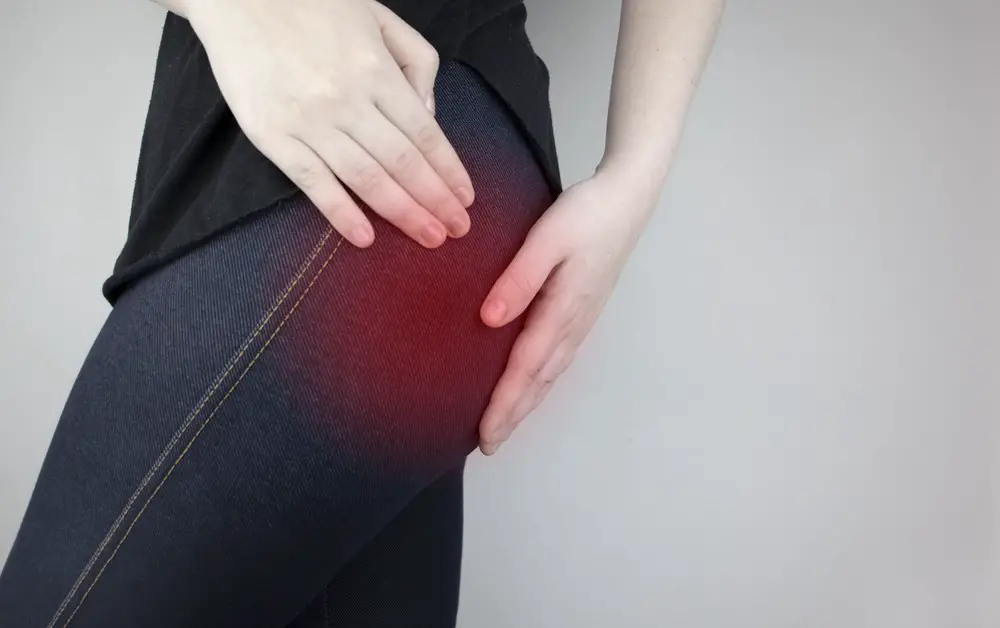As a BetterHelp affiliate, we receive compensation from BetterHelp if you purchase products or services through the links provided
Do you suffer from piriformis syndrome? If so, you know how painful and frustrating it can be. This condition is characterized by pain in the buttocks and the leg, making it difficult to sleep at night. In this article, we will discuss some tips on how to sleep with piriformis syndrome. We will also cover some of the best exercises for pain relief. Let’s get started!
What Is Piriformis Syndrome?
Piriformis syndrome is a condition that results in pain in the buttocks and down the leg. This condition is caused by the piriformis muscle, which is a small muscle located deep in the hip. The piriformis muscle attaches from the lower spine to the top of the thighbone and helps rotate your hip. When this muscle becomes tight or inflamed, it can compress or irritate the sciatic nerve, which runs through the buttock and down the leg. This can result in pain, numbness, or tingling down the leg.
Symptoms Of Piriformis Syndrome
The most common symptom of piriformis syndrome is piriformis pain in the buttocks. This pain may radiate down the leg and worsen when sitting or lying down. Other symptoms may include:
- Difficulty sleeping at night due to pain
- Pain when walking or running
- Stiffness or hip pain
- Numbness or tingling down the leg

Causes Of Piriformis Syndrome
Several things can cause piriformis syndrome, including:
- A direct injury to the muscle, such as from a fall or car accident
- Repetitive stress on the muscle, such as from running or biking
- Poor posture and alignment
- Muscle imbalance in the hips and pelvis
Spinal Alignment
One of the most important things you can do for piriformis syndrome is to ensure that your spine is in proper alignment. This means that your head, shoulders, and hips should be in a straight line when you are standing. If your spine is not aligned correctly, it can put extra stress on the muscles and joints in your hips and pelvis, leading to pain.
Exercises For Piriformis Syndrome
If you suffer from piriformis syndrome, some specific exercises can help. These exercises stretch and strengthen the muscles around the hip to help relieve pain and improve function.
One of the best exercises for piriformis syndrome is the clam exercise. To do this exercise, lie on your side with your knees and feet together. Place your hand on your affected hip. Slowly raise your knee as high as you can without moving your hips or lower back. Hold for five seconds, and then slowly lower your leg back down. Repeat ten times on each side.
Another great exercise is the standing Piriformis stretch. To do this stretch, stand with one foot crossed in front of the other, so your ankle rests on top of your knee. Bend forward at the hips and reach down towards your toes. You should feel a stretch in your buttock. Hold for 30 seconds and then repeat on the other side.
These are just a few exercises that can help with piriformis syndrome. For more information, please consult with a physical therapist or your doctor.

Sleeping With Piriformis Syndrome
Now that we’ve covered some exercises to help with this condition, let’s discuss tips to improve sleep quality with piriformis syndrome. First, of course, sleeping can be difficult when you’re in pain, but there are some things you can do to make it more comfortable.
Back Sleeping:
If you typically sleep on your back, place a pillow under your knees to help relieve pressure on the lower back and hips. You may also want to put a small pillow or towel roll under your buttocks to keep the muscles from becoming too tight.
Side Sleeping:
If you sleep on your side, place a pillow between your knees to keep the hip joints aligned. This will help reduce stress on the muscles and joints and make it easier to fall asleep.
Reclined Position:
If you have trouble sleeping on your back or side, you can try sleeping in a reclined position. To do this, prop yourself with pillows to sit upright in bed. Finding the perfect position may take some trial and error, but it can be a game-changer for people with piriformis syndrome.
Sleeping On Your Stomach:
If you usually sleep on your stomach, it’s best to avoid this position if you have piriformis syndrome. This is because this position can put more pressure on the muscles and sciatic nerve, making pain worse.
These are just a few tips to help you sleep better with piriformis syndrome. Please consult your doctor or physical therapist if you have any questions or concerns.
Pillows Types For Piriformis Syndrome
As we’ve discussed, several different sleeping positions can be helpful for piriformis syndrome. But what type of pillow is best? The answer to this question depends on your sleep position and what works best for you. For example, if you sleep on your back, a pillow under your knees may help relieve pressure on the lower back and hips. On the other hand, if you sleep on your side, a pillow between your knees can keep the hip joints aligned and reduce muscle stress.
There are many different types of pillows available, so it’s essential to find one that suits your needs. You may need to experiment with a few different pillows before you find the perfect one. Here are a couple of things to keep in mind when choosing a pillow:
Your sleep position: As we’ve discussed, different pillows are better for various sleep positions. Make sure to choose a pillow that will work with your preferred position.
Your mattress: If you have a firm mattress, you may need a softer pillow. Conversely, if you have a soft mattress, you may need a firmer pillow.
Your favorite sleeping position: This one is important! Try another position if you love sleeping on your stomach but find that it makes your pain worse. It’s essential to find a position that is comfortable for you and doesn’t aggravate your symptoms.
Many different pillows are available, so take some time to find the perfect one for you. Then, with a little trial and error, you’re sure to find a pillow that helps you sleep better and eases your pain.

Back Sleepers:
If you sleep on your back, place a pillow under your knees to help relieve pressure on the lower back and hips. You may also want to place a small pillow or towel roll under your buttocks to keep the muscles from becoming too tight.
Side Sleepers:
If you sleep on your side, place a pillow between your knees to keep the hip joints aligned. This will help reduce stress on the muscles and joints and make it easier to fall asleep.
Reclining Sleepers:
If you have trouble sleeping on your back or side, you can try sleeping in a reclined position. To do this, prop yourself with pillows to sit upright in bed. Finding the perfect position may take some trial and error, but it can be a game-changer for people with piriformis syndrome.
Stomach Sleepers:
If you usually sleep on your stomach, it’s best to avoid this position if you have piriformis syndrome. This is because this position can put more pressure on the muscles and sciatic nerve, making pain worse.
In Conclusion
These are just a few tips to help you sleep better with piriformis syndrome. Please consult your doctor or physical therapist if you have any questions or concerns. With a little trial and error, you can find a sleeping position that alleviates your pain and helps you get the restful night’s sleep you need.
Article You Might Enjoy Reading
Benefits Of Sleeping With Air Purifier
5 Key Reasons Why Exercise Helps with Stress Management
Why We Catastrophize and What to Do Instead
How to Use Meditation to Boost Sports Performance (Simple Guide for Athletes)
11 Best Smartphone Apps to Monitor Your Mental Health And Wellbeing
- Left Arm Pain and Anxiety: Understanding the Relationship - November 23, 2023
- Anxiety Paralysis: Coping with Overwhelming Stress - November 23, 2023
- Anxious vs. Nervous: Differentiating Emotions and Responses - November 15, 2023
This site contains affiliate links to products. We will receive a commission for purchases made through these links.



